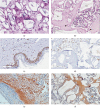The Manufacture of GMP-Grade Bone Marrow Stromal Cells with Validated In Vivo Bone-Forming Potential in an Orthopedic Clinical Center in Brazil
- PMID: 31781235
- PMCID: PMC6875385
- DOI: 10.1155/2019/2608482
The Manufacture of GMP-Grade Bone Marrow Stromal Cells with Validated In Vivo Bone-Forming Potential in an Orthopedic Clinical Center in Brazil
Abstract
In vitro-expanded bone marrow stromal cells (BMSCs) have long been proposed for the treatment of complex bone-related injuries because of their inherent potential to differentiate into multiple skeletal cell types, modulate inflammatory responses, and support angiogenesis. Although a wide variety of methods have been used to expand BMSCs on a large scale by using good manufacturing practice (GMP), little attention has been paid to whether the expansion procedures indeed allow the maintenance of critical cell characteristics and potency, which are crucial for therapeutic effectiveness. Here, we described standard procedures adopted in our facility for the manufacture of clinical-grade BMSC products with a preserved capacity to generate bone in vivo in compliance with the Brazilian regulatory guidelines for cells intended for use in humans. Bone marrow samples were obtained from trabecular bone. After cell isolation in standard monolayer flasks, BMSC expansion was subsequently performed in two cycles, in 2- and 10-layer cell factories, respectively. The average cell yield per cell factory at passage 1 was of 21.93 ± 12.81 × 106 cells, while at passage 2, it was of 83.05 ± 114.72 × 106 cells. All final cellular products were free from contamination with aerobic/anaerobic pathogens, mycoplasma, and bacterial endotoxins. The expanded BMSCs expressed CD73, CD90, CD105, and CD146 and were able to differentiate into osteogenic, chondrogenic, and adipogenic lineages in vitro. Most importantly, nine out of 10 of the cell products formed bone when transplanted in vivo. These validated procedures will serve as the basis for in-house BMSC manufacturing for use in clinical applications in our center.
Copyright © 2019 Rhayra B. Dias et al.
Conflict of interest statement
The authors indicated no potential conflicts of interest.
Figures




Similar articles
-
The Isolation and Manufacture of GMP-Grade Bone Marrow Stromal Cells from Bone Specimens.Methods Mol Biol. 2021;2286:95-105. doi: 10.1007/7651_2020_319. Methods Mol Biol. 2021. PMID: 33534112
-
Hypoxia mediated isolation and expansion enhances the chondrogenic capacity of bone marrow mesenchymal stromal cells.Stem Cell Res Ther. 2012 Mar 2;3(2):9. doi: 10.1186/scrt100. Stem Cell Res Ther. 2012. PMID: 22385573 Free PMC article.
-
Isolation and prolonged expansion of oral mesenchymal stem cells under clinical-grade, GMP-compliant conditions differentially affects "stemness" properties.Stem Cell Res Ther. 2017 Nov 2;8(1):247. doi: 10.1186/s13287-017-0705-0. Stem Cell Res Ther. 2017. PMID: 29096714 Free PMC article.
-
Bone marrow stromal cells (BMSCs) in bone engineering: limitations and recent advances.Ann Biomed Eng. 2004 Jan;32(1):160-5. doi: 10.1023/b:abme.0000007800.89194.95. Ann Biomed Eng. 2004. PMID: 14964731 Review.
-
Postnatal skeletal stem cells.Methods Enzymol. 2006;419:117-48. doi: 10.1016/S0076-6879(06)19006-0. Methods Enzymol. 2006. PMID: 17141054 Review.
Cited by
-
Reduced Osteogenic Differentiation Potential In Vivo in Acute Myeloid Leukaemia Patients Correlates with Decreased BMP4 Expression in Mesenchymal Stromal Cells.Int J Stem Cells. 2022 May 30;15(2):227-232. doi: 10.15283/ijsc21138. Int J Stem Cells. 2022. PMID: 34966001 Free PMC article.
-
Predifferentiated Gingival Stem Cell-Induced Bone Regeneration in Rat Alveolar Bone Defect Model.Tissue Eng Part A. 2021 Mar;27(5-6):424-436. doi: 10.1089/ten.TEA.2020.0052. Epub 2020 Sep 18. Tissue Eng Part A. 2021. PMID: 32729362 Free PMC article.
-
Towards Stem Cell Therapy for Critical-Sized Segmental Bone Defects: Current Trends and Challenges on the Path to Clinical Translation.J Funct Biomater. 2024 May 27;15(6):145. doi: 10.3390/jfb15060145. J Funct Biomater. 2024. PMID: 38921519 Free PMC article. Review.
-
SMURF1 Affects Dental Implant Integration in Diabetes By Regulating PKG2 Expression.Appl Biochem Biotechnol. 2025 Jul 19. doi: 10.1007/s12010-025-05326-w. Online ahead of print. Appl Biochem Biotechnol. 2025. PMID: 40682619
-
The Isolation and Manufacture of GMP-Grade Bone Marrow Stromal Cells from Bone Specimens.Methods Mol Biol. 2021;2286:95-105. doi: 10.1007/7651_2020_319. Methods Mol Biol. 2021. PMID: 33534112
References
-
- Prat S., Gallardo-Villares S., Vives M., et al. Clinical translation of a mesenchymal stromal cell‐based therapy developed in a large animal model and two case studies of the treatment of atrophic pseudoarthrosis. Journal of Tissue Engineering and Regenerative Medicine. 2018;12(1):e532–e540. doi: 10.1002/term.2323. - DOI - PubMed
-
- Giannotti S., Bottai V., Ghilardi M., et al. Treatment of pseudoarthrosis of the upper limb using expanded mesenchymal stem cells: a pilot study. European Review for Medical and Pharmacological Sciences. 2013;17(2):224–227. - PubMed
-
- Lebouvier A., Poignard A., Cavet M., et al. Development of a simple procedure for the treatment of femoral head osteonecrosis with intra-osseous injection of bone marrow mesenchymal stromal cells: study of their biodistribution in the early time points after injection. Stem Cell Research & Therapy. 2015;6(1) doi: 10.1186/s13287-015-0036-y. - DOI - PMC - PubMed
LinkOut - more resources
Full Text Sources
Research Materials

